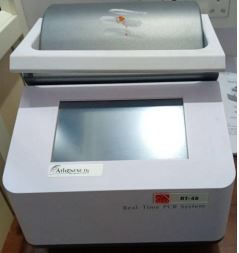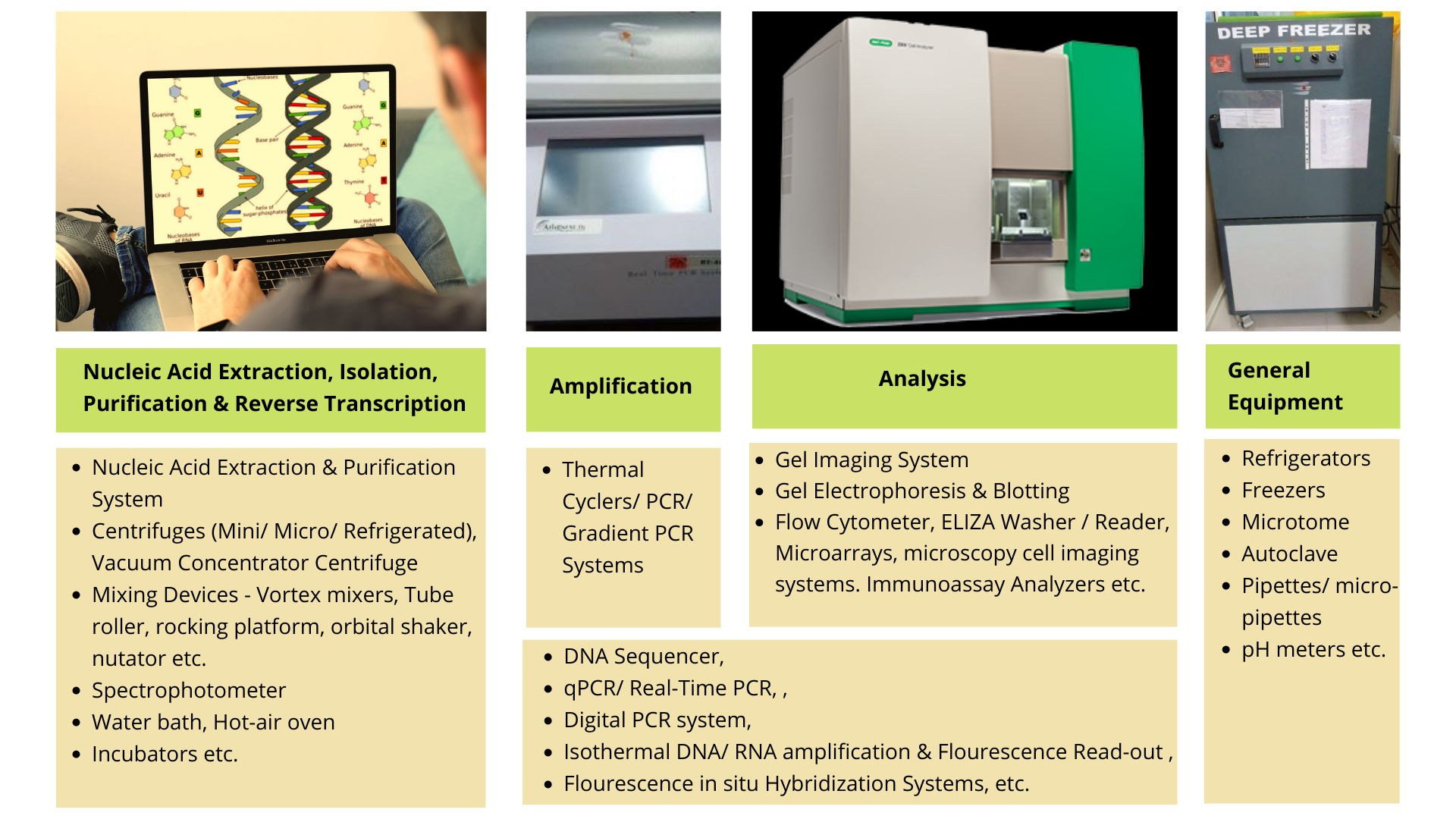
What Is Molecular Diagnostics?
Molecular lab testing involves using various techniques for the detection and/or quantification of specific biological markers in the human, viral, and microbial proteome and genomes. Diseases are identified by studying DNA, RNA, and proteins in fluid or in a tissue, for the DNA or RNA sequences they encode. What are the various medical equipment for molecular diagnostics lab? Lets
Molecular testing is performed for Cancer, Pharmacogenomics (assessing drugs that most suitable for a person – personalized medicine), Genetic testing, Infectious disease, Prenatal, Neurological disease, Cardiovascular disease and even forensic analysis etc. Pathogen detection such as the identification of specific viral infections, including respiratory, urinary, vaginal, sexually-transmitted, gastrointestinal or other pathogens is part of work to identity infectious diseases.
A simple blood sample is enough to obtain genetic information from tumours, transplants or an unborn foetus. This is because nucleic acids required for molecular diagnostics methods capable of detecting sensitive bio-markers from small samples, are available in human plasma. As a result, these tests are less intrusive than say, a traditional biopsy and also capable of early detection.
Molecular diagnostic labs are making a big impact on the treatment of patients, as infectious and other diseases are being detected and treated sooner, with better accuracy. Some of the tests under molecular diagnostics overlap with clinical chemistry (investigations on body fluids) and in vitro biological assays such as PCR-ELISA or Fluorescence in situ hybridization etc.
Polymerase chain reaction (PCR) is the most popular method in molecular diagnostics based on nucleic acid detection. PCR is used to increase the number of nucleic acid molecules, thereby amplifying the target sequence(s) in the sample.
While PCR is currently the most widely used method for detection of DNA sequences, other techniques like Real Time PCR (qPCR), direct sequencing, microarray chips, dPCR etc. are also gaining ground. Microarray chips are prefabricated chips that test many markers at the same time. High-throughput protein arrays can use complementary DNA or antibodies to bind and hence can detect many different proteins at the same time.
Growth of Molecular Diagnostics Lab Equipment Market

Scope for RT-PCR testing has grown manifold in the recent years due to COVID-19. However, even in the future even without Covid testing, RT-PCR / qPCR (also called quantitative PCR) or dPCR (digital PCR) as against traditional PCR are expected to gain ground due to incidence of genetic disorders, prevalence of infectious diseases, growing utilization of bio-markers for disease diagnostics such as Cancer, CVD etc. The advantage of molecular diagnostic methods over other methods, say biopsy, is that it is less invasive and provides an opportunity for early detection and treatment of the underlying disease.
What Equipment Are Needed In A Molecular Diagnostic Lab?
The main products used in molecular diagnostics lab are Equipment/instruments, reagents, and consumables. Reagent are used to cause a chemical reaction. Consumables used are pipettes, micro-pipettes, slides, protective gears etc.
Various types of equipment, reagents and consumables are used based on Technology applied for the testing – DNA sequencing, Polymerase Chain Reaction, Isothermal Nucleic Acid Amplification Technology, Transcription Mediated Amplification, In situ hybridization, Microarrays, Mass spectrometry, Others (southern blotting, northern blotting), Gel or Capillary electrophoresis, STR analysis, Reverse Transcriptase, Direct sequencing, Nucleic acid isolation and quantification etc.
However, all equipment used in molecular diagnostic lab fall in the following four broad categories:
- Nucleic acid (DNA/ RNA) isolation, extraction, purification and processing like Reverse Transcription
- Amplification
- Analysis and
- General Equipment

Depending on the scope of work involved, equipment needed for molecular diagnostic lab typically includes the following:
- Refrigerator
- Freezer
- Vortex Mixer
- Centrifuge
- Thermal Cycler
- Spectrophotometer
- DNA Sequencer
- Microscope
- Electrophoresis System
- Autoclave
- Incubator
- pH Meter
- Microtome
- Water Bath
- Gel Imaging System
- Microcentrifuges
- Orbital Shakers
- Biosafety cabinet
- Laminar Airflow
- Blotting systems
- Hematology Analyzer
- Clinical Chemistry Analyser etc.
- Refrigerator
Refrigerators are used to store laboratory chemicals, reagents, kits and other products at an average temperature of 4 degrees Celsius plus.
- Freezer
Freezers are used to store patient samples and tissue cultures that are frozen. Instead of using two different equipment, a Refrigerator/freezer combination unit can also be used. The temperature range typically needed is from -20 degrees Celsius to -80 degrees Celsius.
- Vortex Mixer
Vortex mixers are used for rapidly mixing liquid components in tubes such as mixing small vials or resuspension of cells. The device consists of an electric motor with a vertical drive shaft attached to a rubber cup mounted slightly off-center. It may have multiple wells each holding test tubes etc. The motor drives the rubber cup in a circular motion with speeds ranging from 100-3600 rpm to create a vortex or a spiral flow within the sample and enabling rapid mixing of fluids.
- Centrifuge
Refrigerated and non-refrigerated centrifuges are used to separate components based on density. Microcentrifuges are also used for small sample quantities rotated at high speeds.
- Thermal Cycler
Thermal cyclers are key equipment for amplification of nucleic acid segments through Polymerase Chain Reaction (PCR). PCR is a method that a template DNA is amplified using synthetic primers – a DNA polymerase and dNTPs. A mixture of nucleic acid sample and primers is cycled between at least 2 temperatures: a high temperature for denaturing double-stranded DNA into single-stranded molecules and a low temperature for the primer to hybridize to the template and for the polymerase to extend the primer. Each temperature cycle theoretically doubles the quantity of target sequence. Detection of amplified DNA sequence could be performed using specialised thermal cyclers, capable of fluorescence detection.
- Spectrophotometer/ Spectroscope
A spectrophotometer is an analytical instrument used for quantitative measurement of visible light, UV light, or infrared light emission or reflection as a function of wavelength. A light beam is passed through the sample of the substance under study. Different components of the sample have varying properties of absorption of light and hence reflect or transmit light differently. Spectrophotometers measure intensity as a function of the wavelength of the light source. In molecular diagnostics lab, Spectrophotometers are used to quantify the nucleic acid in the sample.
- DNA Sequencer
A DNA sequencer is used to know the four-letter sequence of any gene or DNA segment i.e. the sequence of adenine (A), thymine (T), cytosine (C) and guanine (G). This is essential in identifying any human, viral, and microbial or plant genetic material.
- Microscope
Microscopes, especially with camera are used for observing, evaluating samples and storing results.
- Electrophoresis System
Most biomolecules exist as electrically-charged particles in a solution at a given pH, either positively or negatively charged ions. When an electric current is passed through a gel or other matrix, molecular motion relative to the fluid can be observed, under the influence of a spatially uniform electric field. Electrophoresis process is hence used to separate DNA, RNA (nucleic acid) or protein molecules based on their size and electrical charge, DNA sequencing, mutation detection etc.
- Autoclave
Autoclaves are used in labs to sterilize lab equipment and instruments.
- Incubator
Incubators are used to maintain optimal conditions such as temperature and humidity when growing and maintaining cultures.
- pH Meter
pH Meters are used to measure acidity or alkalinity in water-based solutions.
- Microtome
Microtomes are used for sectioning tissue samples. They are cutting tools that produce thin slices or sections of tissues that can be observed under a microscope or other cell imaging systems and analysed.
- Water Bath
A water bath is a device used in labs to incubate samples in water kept at a uniform, controlled, constant temperature.
- Gel Imaging System
Gel Imaging systems are used to record and measure labeled nucleic acid, proteins or antibodies in various types of media such as agarose, acrylamide or cellulose. The samples, loaded onto agarose gels or petri dishes are placed onto a UV (Ultra-violet) transilluminator surface and photo-documented through a CCD or CMOS camera.
- Bio-safety cabinets and laminar airflow – A biosafety cabinet is a biologically safe cabinet, essentially an enclosed, ventilated laboratory workspace for safely working with materials potentially contaminated with pathogens. Laminar air flow is used for aseptic transfer of microbial culture.
- Blotting Systems
Nucleic acid electrophoresis uses a gel matrix to separate DNA and RNA fragments based on size and molecular weight. DNA and RNA fragments, separated by electrophoresis, are transferred to a membrane matrix in blot. Probes are used to detect the presence of target sequences on the membrane matrix. Specific DNA and RNA sequences in a sample are detected by Southern and Northern blots, respectively.
—————————————————————————————————————————
PrimedeQ is an e-Marketplace for buying, selling, renting, servicing and spares of medical equipment. We offer all types of used / refurbished medical equipment , including cathlab, ECG machine and other diagnostic equipment, endoscopes, OT equipment, Laparoscopic Equipment, Lab equipment, X-Ray, TMT, anesthesia machine, ultrasound machines etc. We offer repair services for all types of medical equipment including Lab equipment, microdebrider, laparoscope , rigid and flexible endoscopes as well as EUS (Endoscopic Ultrasound Units) and ultrasound probe etc.
Contact us for any medical equipment requirements 7019759765.






